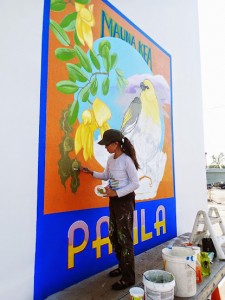04/03/14 – Palila Mural In Downtown Hilo Featured In First Friday Event
Posted on Apr 3, 2014 in Forestry & Wildlife, News ReleasesDEPARTMENT OF LAND AND NATURAL RESOURCES
News Release
| NEIL ABERCROMBIE GOVERNOR |
WILLIAM J. AILA JR,
CHAIRPERSON |
For Immediate News Release April 03, 2014
IN FIRST FRIDAY EVENT
HILO – Hilo’s newest artistic treasure, a mural showcasing the palila (a rare native Hawaiian forest bird), will be showcased in a mini-parade featuring the larger-than-life, gigantic palila this First Friday, April 4. Local artist, Kathleen Kam, teamed up with the Mauna Kea Forest Restoration Project, a project of DLNR and the Pacific Cooperative Studies Unit, to create the 9 by 12-foot mural.
The painting is on the Hilo Loan Shop building in downtown Hilo adjacent to the KTA Super Store and the bustling Hilo Farmers’ Market. The public is invited to celebrate the mural’s completion on Friday at 6:30 p.m. at 64 Mamo St.
The Mauna Kea Forest Restoration Project (MKFRP) commissioned the mural with funds provided by the American Bird Conservancy. Local photographer Jack Jeffrey donated the image that the mural references. The Hilo Loan Shop, Sherwin Williams, HPM Building Supply, and KTA Super Stores also provided generous support that enabled this dream to become a reality.
“We are proud to support Kathleen’s gorgeous mural of this beautiful but highly endangered Hawaiian bird as well as the work DLNR is doing to conserve it,” said Chris Farmer, American Bird Conservancy’s science coordinator for Hawai‘i. “It has been exciting to already have people walking by the mural, stop and talk with us about the artwork and learn about the conservation of palila.”
Palila are a member of the Hawaiian honeycreeper family and are dependent upon native māmane trees for 90 percent of their diet. They were listed as endangered in 1973 under the Endangered Species Act as a result of a drastic population decline due to habitat destruction.
“Palila live in a remote and rugged area of the island that not many people ever visit,” said Robert Stephens, MKFRP coordinator. “The goal of this mural is to inspire and educate the community about palila and how the DLNR is preserving this special, native bird and the māmane-naio forest they depend upon.”
Threats to the palila’s existence have included over-browsing by non-native feral sheep, goats and cattle on māmane seedlings and trees over the past 200 years. In addition to predation by non-native feral cats, the introduction invasive insects and plants, drought, fire and disease.
Currently, palila only occupy a small area on Mauna Kea but used to also live on Mauna Loa, Hualālai, and much more of Mauna Kea. Today, the population is estimated to be between only 1,300 and 1,700 individuals remaining on the planet.
“DLNR’s Division of Forestry and Wildlife (DOFAW) has built 45 miles of sheep-proof fence on Mauna Kea to prevent sheep from entering Palila critical habitat, and removing sheep in those areas, as part of its compliance with a federal court order,” said William J. Aila, Jr., DLNR chairperson. As part of the reforestation project, volunteers have planted more than 80,000 native seedlings on Mauna Kea since 2010.
Kam’s numerous murals on Hawai‘i island and O‘ahu have focused on Hawai‘i’s native plants and animals. She was inspired to do this project because, “This mural’s visual information, which is fueled by a singular message to save a native species, will endure beyond its intrinsic value,” she said.
Kam depicted the mural in the style of a 1940s-era fruit crate label. She said, “It was the perfect fit in its simplicity and aesthetics, and familiar to Hilo’s agricultural community.”
To learn more about palila and how DLNR is protecting Hawai‘i for generations to come, visit: www.RestoreMaunaKea.org
